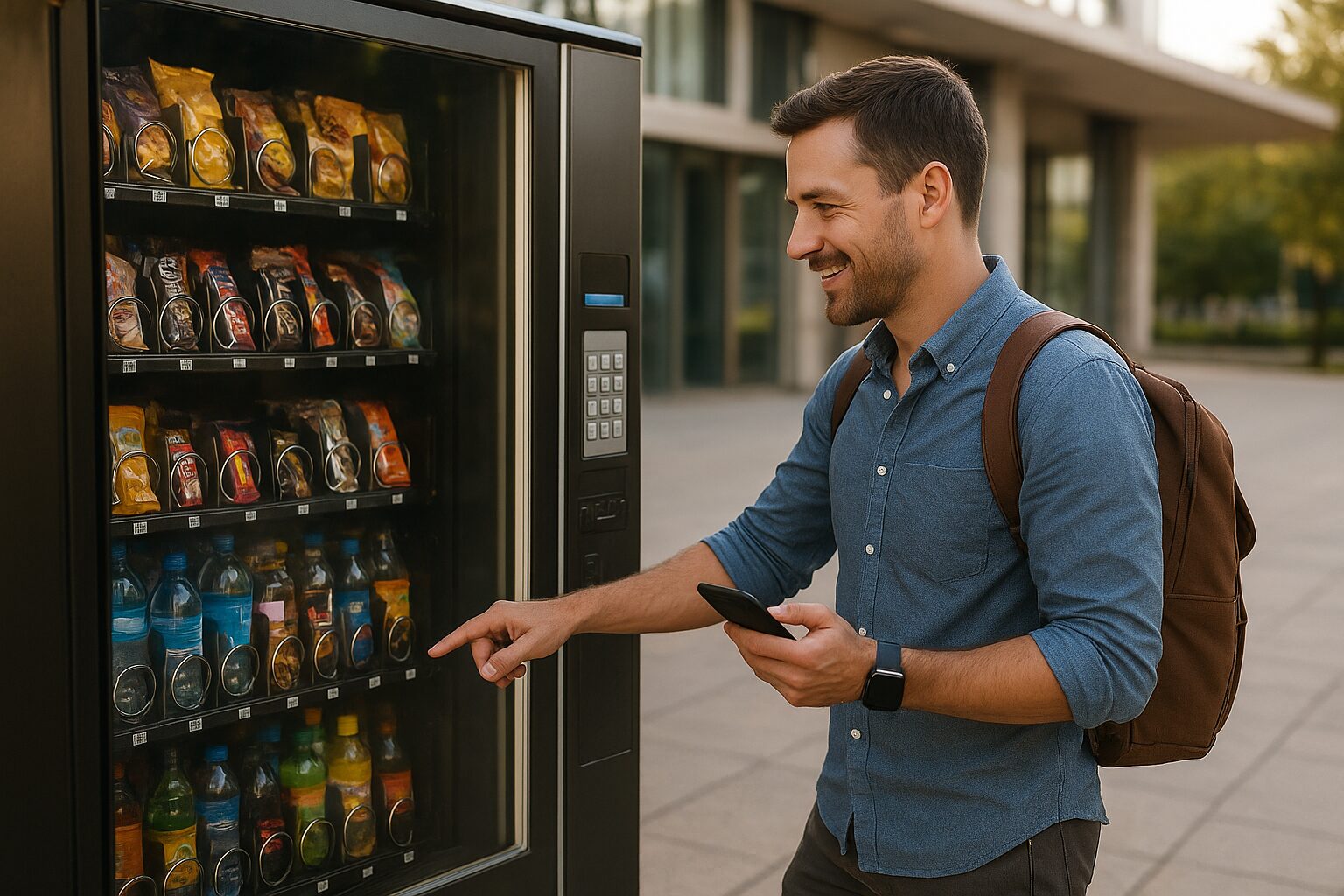A vending machine business is a low-maintenance way to earn passive income by selling snacks, beverages, or other products through automated machines. It’s ideal for entrepreneurs who want flexibility and minimal daily involvement.
With the rise of cashless payments, smart vending machines, and new product options, this business model has evolved beyond just chips and soda. In 2025, it’s one of the most accessible ways to start a small business with high earning potential.
Overview of the Vending Machine Industry in 2025
The global vending machine market is expected to reach $30 billion by 2025, driven by innovations in AI, remote monitoring, and eco-friendly machines. In the U.S. and Asia, vending machines are even expanding into niche categories like healthy snacks, tech accessories, and personal care products.
Why It’s a Popular Choice for Passive Income
Unlike traditional businesses, vending machines work 24/7. Once you secure a good location and keep them stocked, they earn income while you sleep. Entrepreneurs love it because it requires low overhead, no employees, and scalable growth.
Getting Started
Understanding the Market
Before you buy a machine, research your target market. Are you catering to office workers, gym-goers, or students? The key is to match your products with the audience.
Popular vending products in 2025 include:
- Protein bars and bottled water (for gyms)
- Coffee and snacks (for offices)
- Energy drinks and chips (for schools)
- Eco-friendly products like reusable bottles
Identifying Profitable Locations
Location is everything. High-traffic areas ensure consistent sales.
Top-performing spots include:
- Office buildings and coworking spaces
- Hospitals and clinics
- Airports, bus stations, and train terminals
- Universities and dormitories
Initial Investment and Costs
Startup costs depend on machine type, location fees, and inventory. Here’s a quick breakdown:
- Vending machine: $2,000 – $10,000 per unit
- Stock and products: $300 – $1,000 per machine
- Maintenance and repairs: $50 – $150/month
- Business license and permits: $200 – $500
Choosing the Right Vending Machines
Types of Vending Machines
- Snack Machines – Best for chips, candy, and packaged snacks.
- Beverage Machines – Sell sodas, water, juices, and coffee.
- Combo Machines – Offer both drinks and snacks in one unit.
- Specialized Machines – Dispense hygiene kits, PPE, electronics, or even hot meals.
Smart Vending Machines
Smart vending machines in 2025 come with AI-powered analytics, touchless payments, and real-time inventory tracking. These machines send alerts when stock runs low, reducing manual work and boosting sales efficiency.
Key Factors When Choosing
- Capacity – Bigger machines require fewer restocks.
- Payment Systems – Ensure support for card, mobile, and crypto payments.
- Energy Efficiency – Choose energy-saving machines to reduce costs.
Location, Location, Location
How to Find High-Traffic Areas
Scout areas with heavy foot traffic and little snack competition. Observe peak hours to estimate potential demand.
Negotiating with Property Owners
Offer a commission (usually 10–20% of sales) to property owners. Draft a simple contract outlining responsibilities for electricity, cleaning, and revenue sharing.
Common Placement Spots
- Schools and colleges
- Hotels and lobbies
- Malls and shopping centers
- Apartment complexes
Licenses and Permits
Required Business Documents
To operate legally, you need:
- Business license (local or state-level)
- Vendor or food permit if selling perishable items
- Sales tax registration number
Health and Safety Regulations
Machines selling food must meet local health standards. Check refrigeration, expiration dates, and cleanliness regularly.
Taxes and Insurance
You’ll pay income tax on profits and possibly local business tax. Insurance (liability and property) protects your machines from theft or damage.
Stocking and Managing Inventory
Choosing the Right Products
Base your product selection on customer demographics and sales data. Healthy and organic options are trending in 2025.
Top-performing items:
- Bottled water and protein shakes
- Energy drinks and coffee
- Low-calorie snacks
- Local and branded treats
Supply Chain Management
Buy wholesale from reliable suppliers. You can also partner with local brands to offer exclusive products.
Efficient Stock Management
Use smart vending software to track product performance. Replace slow-moving items quickly to maximize sales.
Vending Machine Profitability Snapshot (2025)
| Machine Type | Avg. Monthly Sales | Profit Margin | Payback Period |
|---|---|---|---|
| Snack Vending | $400 – $800 | 35% – 50% | 12–18 months |
| Beverage Vending | $600 – $1,200 | 40% – 55% | 10–15 months |
| Combo Machines | $800 – $1,500 | 45% – 60% | 8–12 months |
Marketing Your Vending Machines
Advertising and Visibility
Brand your machines with colorful graphics and LED lighting. A well-designed machine attracts more users.
Promotions and Loyalty Programs
Offer discounts or “buy 2 get 1 free” deals. QR code loyalty systems are popular—customers scan and collect points for free snacks.
Social Media Promotion
Post your vending machine locations on Google Maps and social platforms. Encourage users to tag your machines for discounts.
Maintenance and Troubleshooting
Common Technical Issues
- Coin jams
- Card reader errors
- Cooling or temperature issues
Keep spare parts and learn basic repair skills to avoid downtime.
Regular Maintenance
Schedule cleaning and restocking at least twice a week. Use eco-friendly cleaners to maintain hygiene standards.
Handling Complaints
Provide a customer support number or QR code on each machine. Offer refunds quickly to maintain trust and reputation.
Scaling Your Vending Machine Business
Expanding to Multiple Locations
Once you master one or two machines, scale up. Target corporate offices or franchise opportunities to expand your footprint.
Building a Network for Passive Income
Link your machines through smart management software. You can monitor performance, restock alerts, and payments remotely.
Automating Processes
Automated inventory alerts and digital payment systems allow you to manage your business anywhere, anytime.
Maximizing Profits and Minimizing Risks
Track and Analyze Sales
Use data analytics to identify best-selling products and time-of-day trends. Focus on top performers to boost profits.
Stay Competitive
Monitor nearby vending businesses. Refresh product variety often to attract repeat customers.
Keep Up with Trends
In 2025, new vending innovations include AI pricing models, solar-powered machines, and crypto payments. Staying updated keeps your business future-proof.
Conclusion
Starting a vending machine business in 2025 is one of the simplest ways to build steady passive income with minimal effort. From choosing the right machines to finding ideal locations, the steps are simple—but the rewards can be long-term.
Key Takeaways
- Start small, scale smart.
- Prioritize good locations and reliable machines.
- Use tech tools to track inventory and sales.
- Stay adaptable to consumer trends.
Frequently Asked Questions (FAQs)
1. How much does it cost to start a vending machine business?
You can start with $2,000–$5,000 for a basic machine and inventory.
2. How much profit can I make per machine?
Most machines generate $300–$800 in profit monthly depending on traffic.
3. Do vending machines need a business license?
Yes, you need a local business license and possibly a vendor or food permit.
4. How often should I restock my vending machine?
Usually once or twice a week, depending on product sales.
5. Can I run a vending machine business part-time?
Yes! It’s a great side hustle since most tasks are automated.
6. What products sell best in 2025?
Healthy snacks, energy drinks, and protein bars are top sellers.
7. Where are the most profitable locations?
Gyms, offices, schools, and hospitals offer the best consistent traffic.
8. What is a smart vending machine?
It’s a tech-enabled machine with remote tracking, cashless payments, and AI analytics.
9. How long does it take to see ROI?
Typically within 12–18 months, depending on machine cost and location.
10. Is the vending machine business still profitable in 2025?
Yes, with smart tech and new product trends, it remains a strong passive income source.
Disclaimer
This article is for informational purposes only and does not constitute financial or legal advice. Please consult with a licensed professional before starting any business venture.



